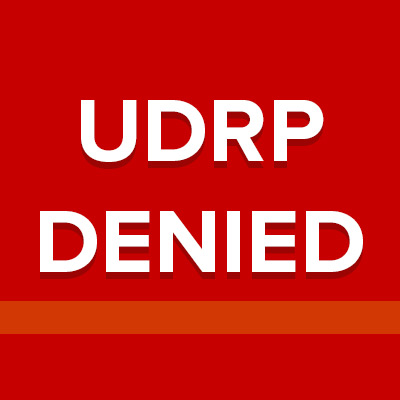
UDRP has been denied.
The owner of ClearBank.org, a domain registered in 2013, was sent a UDRP notice they did not respond to.
The domain predates the registration of the CLEARBANK trademark by three years. The Complainant, ClearBank Limited of London, United Kingdom claimed that they have rights to the domain due to this mark.
Bah humbug, said the sole panelist at the WIPO, John Swinson, noting that the domain is actually older than any trademarks established by the bank, and denied the transfer.
It’s interesting to note that the bank operates from the new gTLD domain, Clear.Bank and that the domain ClearBank.com is not owned by them.
Was the UDRP against the .ORG a bridge attempt, in order to establish a favorable decision for the .ORG and move onto the .com?
Quite possible.
Full details of this decision for ClearBank.org follow:
Copyright © 2025 DomainGang.com · All Rights Reserved.WIPO Arbitration and Mediation Center
ADMINISTRATIVE PANEL DECISION
ClearBank Limited v. Nick Brown
Case No. D2018-24821. The Parties
The Complainant is ClearBank Limited of London, United Kingdom of Great Britain and Northern Ireland (“United Kingdom”), represented by Lawdit Solicitors, United Kingdom.
The Respondent is Nick Brown of Petaluma, California, United States of America (“United States”).
2. The Domain Name and Registrar
The disputed domain name <clearbank.org> (the “Disputed Domain Name”) is registered with FastDomain, Inc. (the “Registrar”).
3. Procedural History
The Complaint was filed with the WIPO Arbitration and Mediation Center (the “Center”) on October 31, 2018. On October 31, 2018, the Center transmitted by email to the Registrar a request for registrar verification in connection with the Disputed Domain Name. On November 5, 2018, the Registrar transmitted by email to the Center its verification response confirming that the Respondent is listed as the registrant and providing the contact details.
The Center verified that the Complaint satisfied the formal requirements of the Uniform Domain Name Dispute Resolution Policy (the “Policy” or “UDRP”), the Rules for Uniform Domain Name Dispute Resolution Policy (the “Rules”), and the WIPO Supplemental Rules for Uniform Domain Name Dispute Resolution Policy (the “Supplemental Rules”).
In accordance with the Rules, paragraphs 2 and 4, the Center formally notified the Respondent of the Complaint, and the proceedings commenced on November 8, 2018. In accordance with the Rules, paragraph 5, the due date for Response was November 28, 2018. The Respondent did not submit any response. Accordingly, the Center notified the Respondent’s default on November 29, 2018.
The Center appointed John Swinson as the sole panelist in this matter on December 11, 2018. The Panel finds that it was properly constituted. The Panel has submitted the Statement of Acceptance and Declaration of Impartiality and Independence, as required by the Center to ensure compliance with the Rules, paragraph 7.
4. Factual Background
The Complainant is ClearBank Limited. According to the Complaint, the Complainant is the United Kingdom’s first clearing bank in more than 250 years. The Complainant was incorporated in 2015.
The Complainant owns a number of registered trade marks for CLEARBANK. Based on the information provided by the Complainant, the earliest of these registrations appears to be European Union registered trade mark number 015011141, filed on January 18, 2016 and registered on May 30, 2016 (the “Trade Mark”). The Complainant offers its banking services via a website at <clear.bank>.
The Respondent did not file a Response, and consequently little information is known about the Respondent.
The Respondent registered the Disputed Domain Name on January 4, 2013. The Disputed Domain Name currently redirects to the domain name <clearpurchase.com>. The website at <clearpurchase.com> relates to a payment system for developing economies, said to be launching in 2019.
5. Parties’ Contentions
A. ComplainantThe Complainant makes the following contentions.
Identical or Confusingly SimilarThe Complainant has registered rights in the Trade Mark. The Disputed Domain Name is identical to the Trade Mark. The generic Top-Level Domain (“gTLD”) “.org” may be disregarded in the determination of confusing similarity under the conventions of the UDRP.
Rights or Legitimate InterestsTo the best of the Complainant’s knowledge and belief, the Respondent has no rights or legitimate interests in respect of the Disputed Domain Name, and has never been authorized by the Complainant to use the Trade Mark.
Before any notice to the Respondent of the dispute, the Respondent has not used, or made demonstrable preparations to use, the Disputed Domain Name in connection with a bona fide offering of goods or services. The Disputed Domain Name redirects to the domain name <clearpurchase.com> which provides digital finance and banking solutions for developing countries. While generally there is nothing illegitimate in using a domain parking service, such use of the Disputed Domain Name, which is confusingly similar to the Trade Mark, does not provide a legitimate interest in the Disputed Domain Name under the Policy.
Further, to the best of the Complainant’s knowledge and belief, the Respondent (as an individual, business, or other organization) has not been commonly known by the Disputed Domain Name.
Finally, the Respondent is not making a legitimate noncommercial or fair use of the Disputed Domain Name, without intent for commercial gain to misleadingly divert consumers or to tarnish the trademark or service mark at issue.
Registered and Used in Bad FaithThe Disputed Domain Name was registered and is being used in bad faith.
The Respondent is using the Disputed Domain Name intentionally to attract, for commercial gain, Internet users to his website by creating a likelihood of confusion with the Trade Mark as to the source, sponsorship, affiliation or endorsement of his website, contrary to paragraph 4(b)(iv) of the Policy.
The Disputed Domain Name is identical or similar to the Trade Mark, so that its registration prevents the Complainant from reflecting its trade mark in a corresponding domain name.
Further, the Disputed Domain Name incorporates a well-known trade mark with no plausible explanation for having done so, and it is not possible to imagine any future use by the Respondent of the Disputed Domain Name which would not be in bad faith.
B. Respondent
The Respondent did not reply to the Complainant’s contentions.
6. Discussion and Findings
To succeed, the Complainant must demonstrate that all of the elements enumerated in paragraph 4(a) of the Policy have been satisfied, namely:
(i) the Disputed Domain Name is identical or confusingly similar to a trade mark or service mark in which the Complainant has rights; and
(ii) the Respondent has no rights or legitimate interests in respect of the Disputed Domain Name; and
(iii) the Disputed Domain Name has been registered and is being used in bad faith.
The onus of proving these elements remains on the Complainant even though Respondent has not filed a Response.
The Respondent’s failure to file a Response does not automatically result in a decision in favor of the Complainant (see, e.g., Airbus SAS, Airbus Operations GmbH v. Alesini Pablo Hernan / PrivacyProtect.org, WIPO Case No. D2013-2059). However, the Panel may draw appropriate inferences from the Respondent’s default.
A. Identical or Confusingly Similar
Paragraph 4(a)(i) of the Policy provides that the Complainant must establish that the Disputed Domain Name is identical or confusingly similar to a trade mark in which the Complainant has rights.
The Disputed Domain Name is identical to the Trade Mark. It incorporates the Trade Mark in its entirety, and no other terms have been added.
The Complainant succeeds on the first element of the policy.
B. Rights or Legitimate Interests
Paragraph 4(a)(ii) of the Policy provides that the Complainant must establish that the Respondent has no rights or legitimate interests in respect of the Disputed Domain Name. The Complainant is required to make out a prima facie case showing that the Respondent lacks rights or legitimate interests.
The Panel finds that the Complainant has made out a prima facie case. This finding is based on the following:
– The Respondent is not using the Disputed Domain Name in connection with a bona fide offering of goods or services. The Disputed Domain Name redirects to a website at <clearpuchase.com> which offers (or will offer) payment solutions for developing economies. It appears the Respondent intends to offer such services under the brand “Clear Purchase”. Such use of the Disputed Domain Name, which incorporates the Trade Mark on the available record, does not confer rights or legitimate interests for the purpose of the Policy.
– There is no evidence that the Respondent is commonly known by the Disputed Domain Name, or has any registered or common law rights in the Disputed Domain Name. As mentioned above, it appears the Respondent will offer its services under the brand name “Clear Purchase”.
– The Respondent has not been making a legitimate noncommercial or fair use of the Disputed Domain Name without intent for commercial gain.
The Respondent had the opportunity to demonstrate his rights or legitimate interests, but did not do so. As such, the prima facie case established by the Complainant has not been rebutted and the Complainant succeeds on the second element of the Policy.
C. Registered and Used in Bad FaithParagraph 4(a)(iii) of the Policy provides that the Complainant must establish that the Respondent registered and subsequently used the Disputed Domain Name in bad faith.
To succeed in a complaint under the Policy, it is well established that under the third element of the Policy, the first thing that a complainant must prove on the preponderance of the evidence is that the domain name in issue was registered in bad faith, i.e., was registered with the complainant and/or its trade mark in mind.
Where a respondent registers a domain name before the complainant’s trade mark rights accrue, a panel will not normally find bad faith on the part of the respondent (see WIPO Overview of WIPO Panel Views on Selected UDRP Questions, Third Edition (“WIPO Overview 3.0”), section 3.8.1). No amount of subsequent bad faith use can convert a good faith registration into a bad faith registration (Green Tyre Company Plc. v. Shannon Group, WIPO Case No. D2005-0877).
Here, the Complainant submits that, because the Disputed Domain Name incorporates the Trade Mark (which, according to the Complainant, is well-known), with no plausible explanation for having done so, it is not possible to imagine any use by the Respondent of the Disputed Domain Name which would not be in bad faith. However, the Complainant has failed to address the fact that the Respondent registered the Disputed Domain Name in 2013, which, by the Complainant’s own submission, is two years before the Complainant started offering its banking services, and three years before the Complainant obtained registered rights in the Trade Mark.
Further, based on independent research conducted by the Panel (as it is entitled to do pursuant to paragraph 10 of the Rules), the Disputed Domain Name has redirected to the Respondent’s website at <clearpurchase.com> since at least as early as December 2014, which is also before the Complainant began operating under the Trade Mark.
Here, the Panel has no basis on which to find that the Respondent actively targeted the Complainant or the Trade Mark, and there are no other factors present which may otherwise support a finding of bad faith.
In light of the above, the Panel finds that the Complainant has not established the third element of the Policy.
7. Decision
For the foregoing reasons, the Complaint is denied.
John Swinson
Sole Panelist
Date: December 19, 2018












